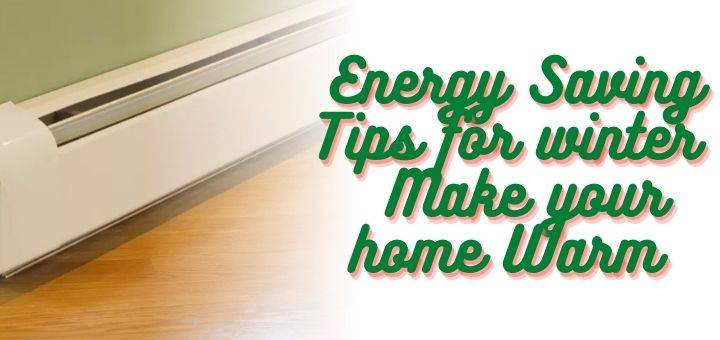Energy Saving Tips for winter as individuals, with tough economic times, many of us are on the lookout for tips and tricks that can save us money especially during the winter when the electric bill goes through the roof. We are more than willing to do what we can to reduce our energy consumption.
Energy Saving Tips for winter Make your home warm this winter

In this article, we are going to break down for you some simple things you can do around your house that you can save money on. Best Hydronic Baseboard Heaters
1. Seal Your Leaks
Common habits such as switching electrical gadgets off instead of leaving them on standby and using energy-saving light bulbs can cut down on your energy consumption down.
If you have a heating system, in your home, check your windows and doors for any cold air that may be coming in and fix it. Some of the heat gets away from your room or space or gets influenced by hot or cold air coming into the space if there is a crack or an opening.
By sealing your windows with weatherproof strips and making sure the doors are properly closed and have no gaps in the frames, you will contain the heat in your home.
Also, insulate your water heater and hot water pipes to prevent heat loss.
2. Control Your Thermostat
Set your thermostat as high as you are comfortable with. To save on your energy bill, lower your thermostat to 65 degrees for 8 hours a day. You can save 10% on your heating bill. The best time for this may be at night when everyone is tucked in their beds.
Secondly, to better manage your thermostat, it is advisable to lower the thermostat setting gradually as opposed to fast when changing its setting. It will cut down on your energy consumption much better than you would if you changed it quickly.
If you have your ceiling fan on, you can raise the temperature on your thermostat by 4 degrees without noticing a difference in your comfort level.
3. Managing the small things.
Small things such as keeping your mobile phone charger, iPod, or iPhone charger plugged in account for the largest energy-related expense for most homes as it accounts for about over 50% of the overall energy used by a household.
Any charger left plugged in twenty-four-seven will keep charging your electrical bill as well. Do yourself a huge favor, unplug your digital clocks, and make sure you turn off all the night lights when you leave for work. And don’t forget to turn off the computer screen when not in use.
Turn off kitchen fans and the ventilating fans in the bathroom 20 minutes after you are done cooking or bathing to keep the warm air in the room.
You can shorten your time in the shower or bath by just 5 minutes. If you can eliminate taking baths you would lower your water heater bill and water bill because you use less water when you take a shower.
To save on your water heater bill, which accounts for 14-25% of your energy use, make sure you’re not running your dishwasher or washing machine unless it is a full load.
Also, you can save up to 90% of your laundry machine energy if you wash more using cooler water.
If not using the water heater Make sure to repair leaky faucets as soon as you see the leak, nobody wants to pay for water that is going to waste.
When preparing dinner, use the appropriate size pot to cook in, and the right size burner for the pot. If you are cooking only for one or two, it is recommended to use small pots. They use less energy.
Use the microwave where you can, it uses a lot less energy than the oven, or even better buy yourself a convection oven. The more heat you use on your oven, the harder the air conditioner has to work to cool down your space.
4. Managing the baseboard heater

If you have a baseboard heater you can properly manage the heater by changing filters on furnaces once a month or as needed.
Make sure your radiators and baseboard heaters aren’t blocked by any carpeting, drapes, or other objects.
Clean your radiators and baseboard heaters regularly. Placing a heat-resistant radiator reflector between the radiator and exterior walls of a home or apartment, ensures appropriate heat disbursement rather than placing the radiator against the wall as it wastes energy and increases the utility bill.
Guide to Hydronic Baseboard Heaters
Warm up yourself during this winter with a baseboard heater and you could be looking at warm, cozy days. Baseboard Heaters provide the perfect temperatures for your home at a time when we need to keep ourselves warm.
If you are shopping for a heating unit, there are several versions of baseboard heaters such; as portable electric baseboard heaters, residential convection heaters, hydronic convection baseboard heaters, and commercial convection baseboard heaters.
This can become a little overwhelming to figure out which specific appliance to choose.
Nonetheless, in this post, we will pay closer attention to residential convection heaters which are also hydronic baseboard heaters. Fortunately, there’s some information that can help get to the heart of this baseboard heater.
Hydronic baseboard heaters are a perfect convenience for any living space. A straightforward and suitable approach to overcoming heat loss, they contain an immersion heating element in an anti-freeze solution that delivers warmth through a swift and simple technique of radiation to any area of your home.
These efficient Baseboard Heaters come fitted with stainless steel heating elements. The stainless steel heating elements heat up slowly converting almost all energy consumed into heat warming the anti-freeze solution to provide effective heating. Thus we can outrightly say they are thermally efficient.
Hydronic baseboard heaters are available in various sizes ranging from 24 inches wide to 84 inches wide. They are usually installed along the base of a wall and are heated with the help of electric power. They are connected with a series of pipes that are designed to transfer heat to various rooms.
Since there’s no interior fan that blows out hot air and no moving parts, this appliance differs from the typical electric heater.
They are a silent heating solution for hallways and bedrooms, a baby’s room, or any other place in the home where you would like to have peace and tranquility.
Hydronic baseboard heaters have a reputation for being a suitable alternative or supplement for other heating sources because they don’t take up much space at all.
Considering the energy efficiency and ease of installation, they are a very energy-efficient alternative to the typical electric heater because, after the heater warms all the air in the room to the desired temperature, it automatically shuts itself off, conserving energy. Many people use these appliances as their central heating unit.
To keep hydronic baseboard heaters from detracting from the general decor or design of your room, there is a spread of covers available that will either hide or keep it in the overall design of its setting.
The covers are possible for the DIY’er to replace. If you intend to replace them the steps are quite easy to follow that can take about an hour and a half to complete the replacement.
Start by removing the front cover and movable vent pieces. Next, locate the mounting screws or nails the plumber used when he installed the first baseboard.
Using a screw gun, pry bar, and a pair of good quality metal snips, removal of the old pieces is not too difficult. After removing all the mounting screws or nails, you will have to wrestle them backplate out from behind the heat piping
Carefully slide the new backer plate down behind the heat piping. It will be a very tight fit. If there is a little slack in the holes where the piping passes through the floor that also helps you to move the piping a little and aids in letting you slide the new backer plate in place.
With the new plate in situ, slide the backer plate up until the flat pad mounts for the warmth piping again slip around the square fins.
Once everything is clear of the piping, clean the heating fins to remove all dirt and dust, once again being careful not to touch the fins with your bare hands.
Conclusion
These are simple and easy-to-do steps that are recommended by The American Council for Energy Efficiency. By following these simple steps you can save between 30 and 40 percent on energy if you follow these simple steps. To keep things simple learn more about hydronic baseboard heaters here.
- 25 Easy Crafts to Make and Sell Fast for Profit at Home - June 21, 2025
- 16 Essential Fall Maintenance Tasks to Prep Your Home for Winter - June 17, 2025
- Summer Home Prep: What to Fix and Clean Before the Heat Hits - June 14, 2025

